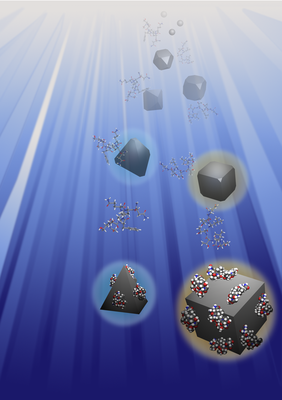Currently, some 20 percent of the world’s industrial production is based on catalysts — molecules that can quicken the pace of chemical reactions by factors of billions. Oil, pharmaceuticals, plastics and countless other products are made by catalysts.
Many are hoping to make current catalysts more efficient, resulting in less energy consumption and less pollution. Highly active and selective nanocatalysts, for example, can be used effectively in efforts to break down pollution, create hydrogen fuel cells, store hydrogen and synthesize fine chemicals. The challenge to date has been developing a method for producing nanocatalysts in a controlled, predictable way.
In a move in this direction, Yu Huang, an assistant professor of materials science and engineering at the UCLA Henry Samueli School of Engineering and Applied Science, and her research team have proposed and demonstrated a new approach to producing nanocrystals with predictable shapes by utilizing surfactants, biomolecules that can bind selectively to certain facets of the crystals’ exposed surfaces.
Their new study can be found online in the journal Nature Chemistry.
At the nanoscale, the physical and chemical properties of materials depend on the materials’ size and shape. The ultimate goal has been to rationally engineer materials to achieve programmable structures and predictable properties, thereby producing the desired functions. Yet shaped nanocrystals are still generally synthesized by trial-and-error, using non-specific molecules as surfactants — a result of the inability to find appropriate molecules to control crystal formation.
Huang’s team’s innovative new work could change that, potentially leading to the ability to rationally produce nanocatalysts with desired shapes and, hence, catalytic properties.
“In our study, we were able to identify specific biomolecules — peptide sequences, in our case — which can recognize a desired crystal surface and produce nanocrystals exposed with a particular surface to control the shape,” said Chin-Yi Chiu, a UCLA Engineering graduate student and lead author of the study.
“Facet-specific biomolecules can be used to direct the growth of nanocrystals, and most importantly, now we can do it in a predictable fashion,” said Huang, also a researcher at UCLA’s California NanoSystems Institute and senior author of the study. “This is still a first step, but we have overcome the challenges by finding the most specific and selective peptide sequences through a rational selection process.”
 Huang’s team accomplished this by using a phage library that generated a pool of peptide sequences. The team was then able to identify the selectivity of peptide sequences on different crystal surfaces. The next step, the researchers say, is to figure out what exactly is happening on the interface and to be able to describe the characterizations of the interface.
Huang’s team accomplished this by using a phage library that generated a pool of peptide sequences. The team was then able to identify the selectivity of peptide sequences on different crystal surfaces. The next step, the researchers say, is to figure out what exactly is happening on the interface and to be able to describe the characterizations of the interface.
“We don’t know the molecular details yet — that’s like the holy grail of molecular biomimetics,” Huang said. “Take the catalyst, for example. If we can predict the synthesized catalyst for just one surface, it could have much more improved activity and selectivity. We are still in the initial phase of what we really want to do, which is to see whether or not we can eventually program the synthesis of material structures.”
“It’s always been a personal interest to learn from the natural evolutionary selection process and apply it to research,” Chiu said. “It is especially satisfying to be able to engineer a rational selection process for nanoscale materials to create nanocrystals with desired shapes.”
The study was funded by the U.S. Office of Naval Research; the U.S. Army Research Office, through the Presidential Early Career Award for Scientists and Engineers (PECASE); and a Sloan Research Fellowship.
Main Image: Biomolecules possess exquisite specific molecular recognition properties that can be explored for precise engineering of nanostructutred materials. Here the facet-specific peptide sequences rationally selected through a biomimetic evolution process are used as regulating agents for predictable synthesis of platinum nanocrystals with selectively exposed crystal surfaces. Inset Image: Platinum nanocrystals selectively shaped using facet-specific peptide sequences. Pt nanocube and Pt nano-tetrahedron are produced by Pt-{100} and Pt-{111} binding peptides, respectively.
